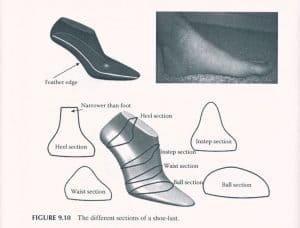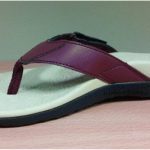
You’ve spent the summer wearing flip-flops, sandals, and going barefoot – now that fall is coming and classes have started, it is time to start thinking about shoes…
If you are run, dance, play soccer, ride bicycles, hike or climb, you probably think about the fit, construction, and “science” of your footwear. But most of us don’t think much about the science of the shoe – we think more about style and comfort (in some cases – about which I may personally know, only the style!).
The human foot is quite complex and consists of 26 bones, 33 joints, plus muscles, tendons, ligaments, and a network of blood vessels, nerves, skin and other soft tissue. It is quite a complex – and flexible – structure providing the body with support, balance, and mobility.
Considering the complexity of the human foot, it is rather amazing that anyone can walk into a shoe store and find shoes that fit (reasonably) well. Men’s, women’s, and children’s feet are all different – not to mention all the individual differences among human beings! There are flat feet, feet with high arches, differences in the width at the ball of the foot, length of toes, narrow heels, the list goes on. Without even looking at the special circumstances of feet with particular needs, the thought of designing a shoe where “one size fits all” is daunting! (Did you know that certain studies have shown that male and females have different length feet, even when they are the same height?)
Ever wonder why shoes of “yesteryear” looked so, well, utilitarian? This can partially be explained by the beginnings of World War II. The height of heels was limited to 2.5 cm (less than an inch) in the United States and .5 cm in Britain. Leather was in short supply, so cheaper, poor-quality leather was used. Once those restrictions were removed, the heels became higher and peep toes emerged! Then as leather became more expensive, cheaper alternatives were found – plastic and synthetic fibers became quite common. Platform shoes have come and gone, as have other particular footwear styles. (Alas, I had a pair of blue denim platform shoes “back in the day.” I miss those shoes….) All these changes were motivated by fashion.
But, what about the science of shoes and designing shoes so they are healthier for the body?
A “shoe-last” is a wooden or plastic mold upon which a shoe is constructed. There are 4 reference points – the vamp, instep, ball break, and heel point (where the backseam is). The shoe-last has evolved based on a women’s American size 6-B shoe and on a men’s American size 7.5C shoe-last.
So, you have “normal” feet – nothing that would cause you to need specialized shoes – what can you expect from standard retail footwear? Generally, there are 5 characteristics: a moderate to low heel (<2 inches); a cushioned midsole; breathable, comfortable uppers; adjustable fastening (laces, straps, etc.); and a stable heel.  There are, obviously, a great many variations on these characteristics and there are many styles that are missing some (or all!) of these characteristics! These 5 characteristics are what are recommended for the most comfortable (and least damaging) day-to-day footwear.
There are, obviously, a great many variations on these characteristics and there are many styles that are missing some (or all!) of these characteristics! These 5 characteristics are what are recommended for the most comfortable (and least damaging) day-to-day footwear.
Okay, about those stylish heels that are so popular. Wearing those heels have been shown to have the following effects (among others): changing the posture & putting weight on the toes; increasing the pelvic tilt; changing the gait; increased activity of lower spine muscles & lower back pain; muscle fatigue and pain; corns & bunions; deformation of the toes; and increased risk of ankle sprains. Benefits? Supposedly the calves look slimmer and the feet look smaller.
Have you heard that going barefoot is healthier than wearing shoes? Check out this abstract – available through PubMed. The Science of Footwear has more in-depth information about the science of athletic shoes, children’s footwear, shoes for the elderly population, and shoes for those with particular, medical shoe needs.
And, just in case you are wondering – yes, conventional wisdom says that flip-flops are not a healthy choice for your feet and joints. Studies have been done on flip-flops and the effects on foot and joint health. One of these studies found a flip-flop with a molded foot-bed may have a significant on foot pain, function, and foot health and “…might be a valuable adjunct therapy for people with foot pain.” (hmm. maybe I can break out my flip-flops again…)
Whether you wear, flip-flops, sandals, stilettos, sneakers, fashion boots or work boots, high-tech running shoes or ordinary sneakers, think about all the science that goes into making them comfortable and better for your feet and joints!
Resources:
Goonetilleke, Ravindra S., editor. 2013. The science of footwear. Boca Raton, FL : CRC Press. Engineering Library TS990 .S334 2013
Chuter, VH, Searle A., Spink MJ. Nov. 11, 2016. Flip-flop footwear with a moulded foot-bed for the treatment of foot pain : a randomised controlled trial. PubMed.
Shakoor, N., Block, JA. Spet. 2006. Walking barefoot decreases loading on the lower extremity joints in knee osteoarthritis. PubMed .
Other Resources:
Falcon, Delialah. May 7, 2016. Weighing the Pros and Cons of Walking Barefoot. symptomfind. IAC Publishing, LLC
Barrett, Stephen, DPM FACFAS. Oct. 3, 2014. Are Flip-Flops Really That Bad for Your Feet? Podiatry Today
Sharpe, T., Malone, A., French, H., Liernan, D., O’Brien, T. May 2016. Effect of flip-flops on lower limb kinematics during walking: a cross-sectional study using three-dimensional gait analysis.PubMed .


